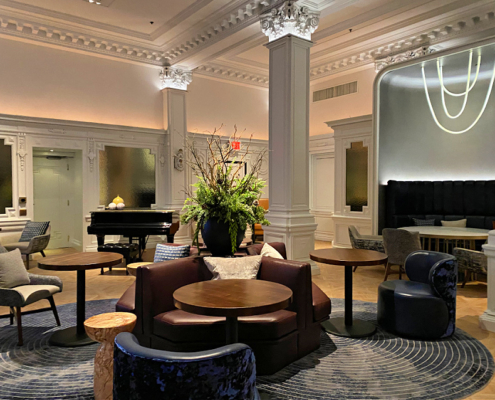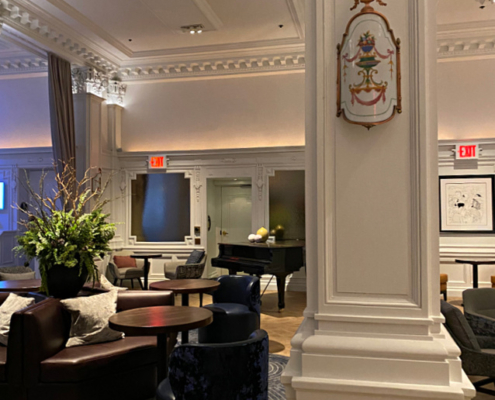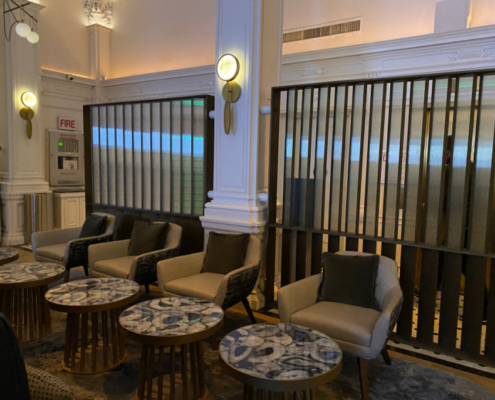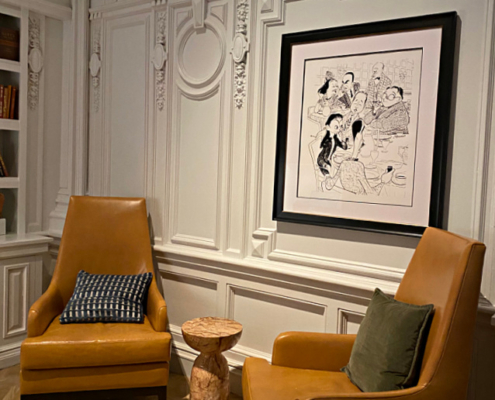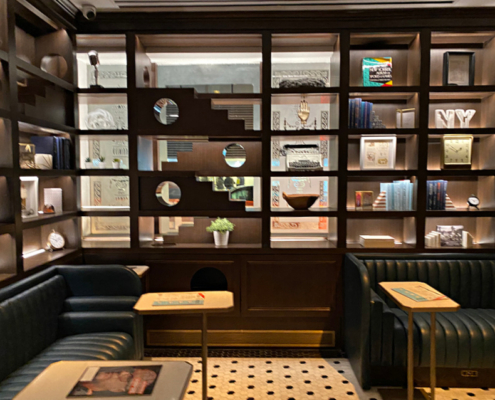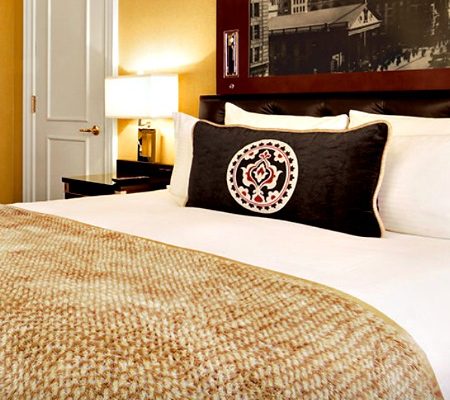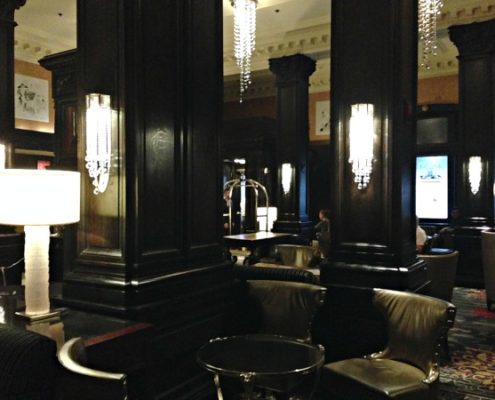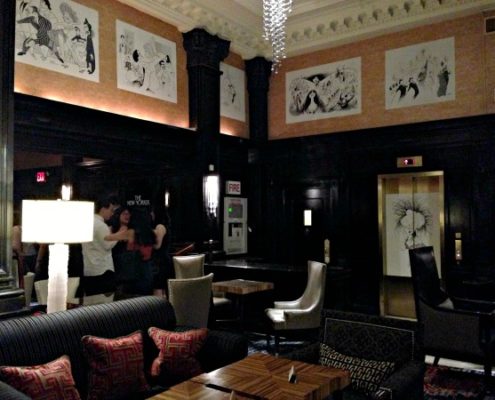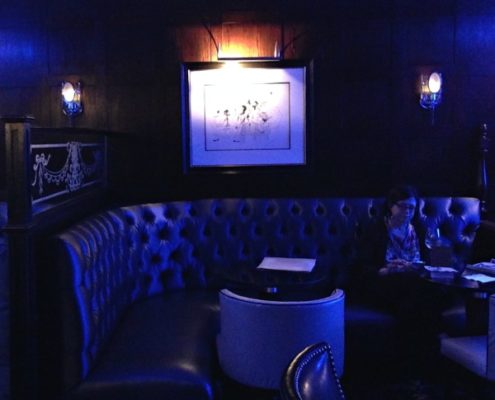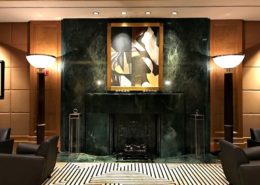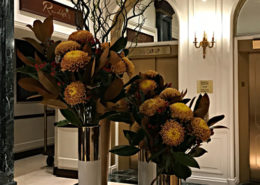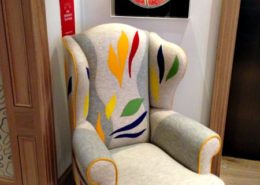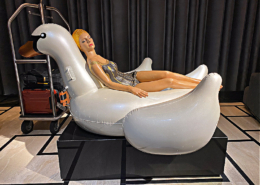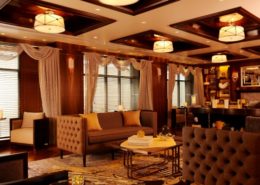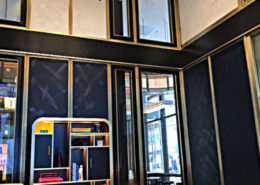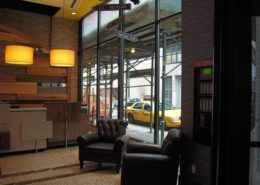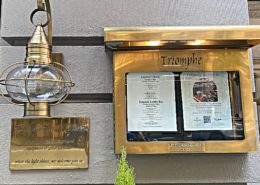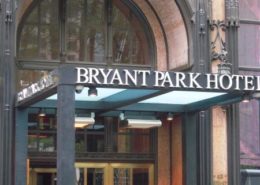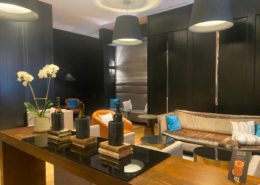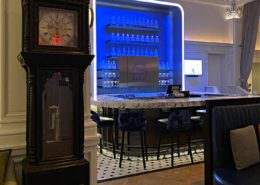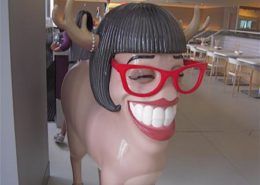The Algonquin Hotel
By Terry Trucco
At a glance: Ask an Algonquin aficionado to identify the hotel’s most salient feature, and you’ll get one of three stock replies. The hotel cat (Hamlet is the latest in a celebrated parade of rescue felines who have prowled the premises for generations). The tight quarters (rooms best described as sybaritic monk cells are sprinkled among more spacious kings and suites). And the majestic oak lobby lounge, an iconic meeting place since the 1920s when the fabled Round Table lunches attracted the era’s A-list writers, editors, actors and wags.
But if you’ve visited since the hotel reopened post-pandemic in 2021, you’ll know the lobby lounge looks, well, different.
The warm, brown woodwork has disappeared under a coat of creamy white paint that’s more evocative of a sunroom than an Ivy League library. Gone, too, is the lounge’s clubby, living room vibe, replaced by a 21st-century open-plan setup unimagined when the hotel was built in 1902. Undeniably lighter and brighter, the place emits an unexpected California feel, thanks in part to a vigorous helping of the color blue, a nod to the Blue Bar, the vaunted watering hole adjoining the hotel that opened with the exit of Prohibition and has been transplanted in the lounge in the shrunken form of a horseshoe-shaped bar backdropped in blue light and outfitted with blue velvet bar stools. (The original Blue Bar is set to reopen as a private meeting space.)
How you’ll react probably depends on your expectations — and age. Devised by Stonehill Taylor, a go-to architectural firm specializing in clever-but-thoughtful hotel design, the space is suited up to take on the 21st century without completely shedding its Edwardian origins. The white paint dramatizes fetching period details like the bold dentil molding and exuberant capitals atop the columns. Vintage drawings of Broadway royalty by the inimitable Al Hirschfeld (Nina’s dad) remind you of the hotel’s blue-chip Theater District bona fides. Seating options abound, as before, so you can pull up to a table, plop onto a sofa or settle into a club chair for a meal, a drink or a tete-a-tete. Look hard enough and hints of the All About Eve aura survive as does the totemic grandfather’s clock. And yes, the lounge is undeniably spiffier than pre-pandemic, a welcome change if you, like us, like spiff.
And the rest of the hotel? Typical of historic properties, the Algonquin remains a quirky place. Updates to the bathrooms, climate control systems, elevators, plumbing and lighting won’t change the narrow-gauge footprint of this 120-plus-year-old building. Food and drink, while improved, are still wildly overpriced, and the servers are still friendly/rude (the service equivalent of jolie/laide). But that can also be called character, depending on your tastes. And the Algonquin still has plenty to go around.
Rooms: The smallest rooms are extremely small with queen-size beds miraculously shoehorned in. But the larger rooms offer space to breathe. A gut renovation in 2012 updated the vital components you can’t see — heating and cooling systems and plumbing — upgrading the hotel’s luxury and comfort quotients. Decor is classic — nothing radical for Manhattan’s longest operating hotel. The soothing colors, tufted headboards, window seats and carpeted floors are tasteful if not groundbreaking. A nice touch is the vintage black-and-white street scene above the bed. Bathrooms are tiled in classic white and can be extremely small. But spacious stall showers have replaced the old tubs, making them feel roomier than they once did.
Amenities: Free WiFi. Complimentary newspapers. The fitness center is open 24 hours.
Surroundings: The Algonquin is smack in the middle of a terrific midtown block packed with low-slung, atmospheric hotels, clubs and office buildings straight out of a black-and-white WeeGee photo. Prime heritage territory is a short walk away — Times Square and the Theater District, Grand Central Station, the New York Public Library, Fifth Avenue shopping and Bryant Park. Rockefeller Center and the Museum of Modern Art are slightly further afield but walkable. Lincoln Center is a three-subway-stop hop. Downtown destinations like SoHo, Tribeca and the Financial District are easily reached by subway. Bus stops are a block away; the subway station is a 3½ block walk.
Back story: Few New York hotels do history as artfully as the Algonquin, perhaps because this is the oldest operating hotel in the city (it opened in 1902). Originally called The Puritan, owner-manager Frank Case changed the name to the Algonquin upon learning that the first residents of the area belonged to that tribe. Case was also responsible for the hotel’s most storied tradition, begun in 1919 — the daily Round Table lunches that attracted writers, editors, actors and journalists and compelled them to be clever. Frequent members of the “Vicious Circle” included Robert Benchley, Alexander Woolcott, Harold Ross and Dorothy Parker.
Case sold the hotel in 1946 to Ben Bodne, a Southerner who oversaw it for over 40 years. He, in turn, sold it to a Japanese concern in 1987, and it has had numerous owners since, culminating in Cornerstone Realty, which purchased it from HEI in 2011. HEI still manages the property. In September 2010, the hotel joined the Marriott International group as part of the Marriott Autograph Collection of historic and one-of-a-kind properties. Besides a new web site, the affiliation introduced valet parking, the gut renovation in 2012 and Marriott Rewards for member guests. During the pandemic shut down, the lobby was renovated as mentioned above, incorporating the storied Blue Bar which previously stood next door.
Keep in mind: Though nicely modernized, the building is old: hallways are narrow, and queen-bed rooms are really small. And courtyard rooms have dismal views.
The Algonquin Hotel
59 West 44th Street
between Fifth and Sixth avenues
New York, NY 10036
212-840-6800
888-304-2047

